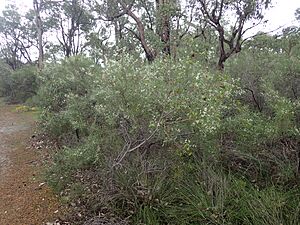Two-leaf facts for kids
Quick facts for kids Two-leaved hakea |
|
|---|---|
 |
|
| Hakea trifurcata growing near Perth | |
| Scientific classification | |
| Genus: |
Hakea
|
| Species: |
trifurcata
|
Hakea trifurcata, also known as two-leaf hakea or kerosene bush, is a special shrub found only in the south-west of Western Australia. This plant is unique because it has two different types of leaves: some are thin and needle-like, while others are wider and shaped like an egg. What's really cool is that its fruit stays green and looks just like the wider leaves. This helps the fruit hide from birds like cockatoos that like to eat seeds.
Contents
About the Two-Leaf Hakea Plant
Hakea trifurcata is a shrub that can grow from about 0.4 to 3 meters (1.3 to 10 feet) tall. It can also spread out to about 3.5 meters (11.5 feet) wide. Unlike some other plants, it doesn't have a special woody base that helps it regrow after a fire.
Leaves of the Hakea Plant
This plant is famous for having two kinds of leaves. Most of its leaves are thin and look like needles. They can be straight or curved, and they are usually between 2.2 and 7.5 centimeters (0.9 to 3 inches) long. These needle-like leaves have a sharp point at the end.
The second type of leaf is wider, shaped like an oblong or egg. These leaves are 2 to 5 centimeters (0.8 to 2 inches) long and 6 to 19 millimeters (0.2 to 0.7 inches) wide. Both types of leaves start out with soft, silky hairs, but they quickly become smooth.
Flowers of the Hakea Plant
The flowers of the two-leaf hakea grow in small groups of one to ten. They are often cream, white, or pink, and they have a strong, sweet smell. These flowers attract bees and birds because they produce a lot of nectar. However, some people have described the smell as "fetid," which means it's not very pleasant.
Fruit of the Hakea Plant
The fruit of Hakea trifurcata is green and smooth. It's shaped like an egg, but it's tilted to one side. These fruits are 1.5 to 2.5 centimeters (0.6 to 1 inch) long. Unlike the fruit of many other hakea species, these fruits are not woody and don't have a beak-like shape. The plant usually flowers between April and October.

Where Two-Leaf Hakea Grows
Two-leaf hakea is found in many places across Western Australia. It grows from north of Geraldton all the way to east of Esperance. You can find it in different types of soil, including sand or laterite (a type of red soil). It often grows in areas with mallee (a type of eucalyptus forest) or low heathland.
How Two-Leaf Hakea Protects Itself
Hakea trifurcata has a clever way to protect its seeds. The broader, egg-shaped leaves only appear when the plant starts to produce fruit. These leaves look very similar to the green fruit in both shape and color.
Scientists have studied this plant to see if these special leaves help hide the fruit from birds that eat seeds, like the short-billed black cockatoo. The broader leaves often fold over, covering the fruit. This makes it very hard for cockatoos to tell the difference between a leaf and a fruit. The leaves even get bigger the further away they are from the fruit, which might confuse the birds even more.
This amazing trick helps the plant keep its seeds safe from being eaten. Botanists have noticed that black cockatoos often perch in hakea bushes and open up the green fruit with their beaks to get to the seeds.
This plant grows in areas where fires happen often. However, it does not regrow from its roots after a fire. So, for new plants to grow, there needs to be a "seed bank" in the soil that survives the fire.
Conservation Status
The Western Australian Government's Department of Parks and Wildlife says that Hakea trifurcata is "not threatened." This means it's not currently at risk of disappearing.


